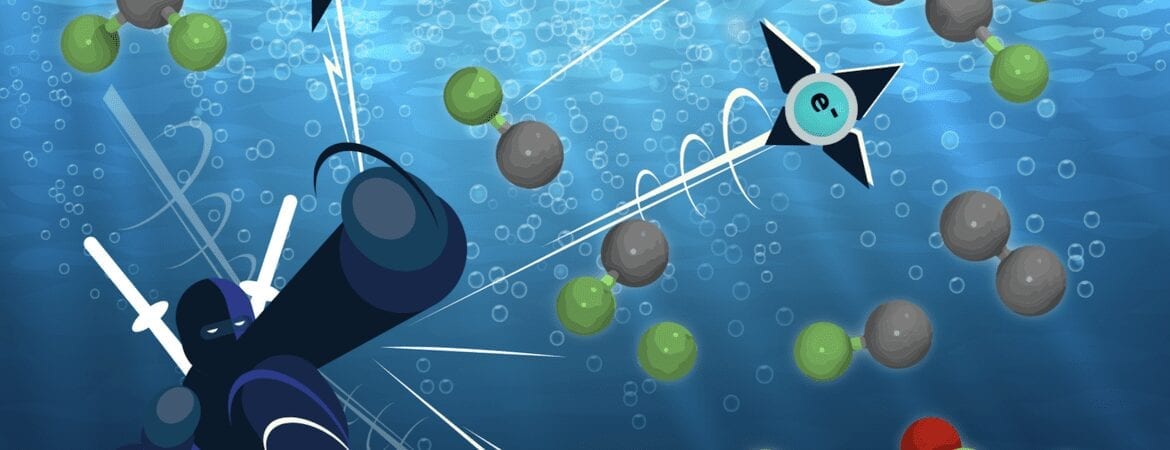
via Sustainability Times
One-two punch of hydrogen and short-wave ultraviolet light infusions destroy PFAS in method designed for future drinking water and toxic site cleanup applications
An insidious category of carcinogenic pollutants known as “forever chemicals” may not be so permanent after all.
University of California, Riverside, chemical engineering and environmental scientists recently published new methods to chemically break up these harmful substances found in drinking water into smaller compounds that are essentially harmless.
The patent-pending process infuses contaminated water with hydrogen, then blasts the water with high-energy, short-wavelength ultraviolet light. The hydrogen polarizes water molecules to make them more reactive, while the light catalyzes chemical reactions that destroy the pollutants, known as PFAS or poly- and per-fluoroalkyl substances.
This one-two punch breaks the strong fluorine-to-carbon chemicals bonds that make these pollutants so persistent and accumulative in the environment. In fact, the molecular destruction of PFAS increased from 10% to nearly 100% when compared to other ultraviolet water-treatment methods, while no other undesirable byproducts or impurities are generated, the UCR scientists reported in a paper recently published in the Journal of Hazardous Materials Letters.
What’s more, the cleanup technology is green.
“After the interaction, hydrogen will become water. The advantage of this technology is that it is very sustainable,” said Haizhou Liu, an associate professor in UCR’s Department of Chemical and Environmental Engineering and the corresponding author of the paper.
Liu’s laboratory developed the technology with help from a $400,000 grant from the National Science Foundation.
PFAS are a family of thousands of chemical compounds characterized by fully fluorinated carbon atoms with stubbornly strong chemical bonds that last indefinitely in the environment – hence the moniker “forever chemicals.” Examples of PFAS-containing products include grease-resistant paper wrappers and containers such as microwave popcorn bags, pizza boxes, and candy wrappers. They are also found in stain and water repellents used on carpets, upholstery, clothing; cleaning products; non-stick cookware; and paints, varnishes, and sealants, according to the U.S. Environmental Protection Agency.
Studies have linked exposure to certain levels of PFAS to many ill health effects, including increased risk for prostate, kidney, and testicular cancers, as well as decreased fertility or increased high blood pressure in pregnant women, developmental effects or delays in children, low birth weight, and accelerated puberty, according to the EPA.
Because of these health effects, federal and state officials are promulgating new cleanup standards for PFAS in drinking water and in groundwater below or emanating from toxic cleanup sites.
Original Article: Water cleanup method developed by University of California, Riverside, scientists destroys pervasive, cancer-causing “forever chemicals” or PFAS
More from: University of California Riverside
The Latest Updates from Bing News
Go deeper with Bing News on:
Forever chemicals
- 'Forever chemicals' discussed at commissioners meeting
Biosolids and PFAS were a topic of discussion at a recent meeting of the Decatur County Commissioners. Commissioner Tony Blodgett read from a report about a new waste treatment plant being considered ...
- A guide to PFAS: From what forever chemicals are to how they can hurt you
Forever chemicals are in dozens of everyday objects and even the water you drink and the air you breathe. Research shows they can be harmful to your health ...
- How Freaked Do Santa Barbarans Need to Be About Forever Chemicals?
While Santa Barbara may not be “in the center of the mess,” the community is “interfacing with PFAS every day,” says city water czar.
- Logan Paul's Energy Drink Company Accused of 'Forever Chemicals,' Excessive Caffeine in Class-Action Lawsuits
In a separate lawsuit filed in August 2023 in California, Prime is accused of containing PFAS, which are synthetic chemicals used in cleaning products, toiletries, and stain-resistant sprays that are ...
- Attorneys Considering Class Action Lawsuit Against Native Over "Forever Chemicals" Concerns
Native, a personal care brand many people turn to when they're looking for naturally-minded grooming products — which includes deodorant, shampoo, conditioner, and more — is under scrutiny, after news ...
Go deeper with Bing News on:
PFAS
- Rover looks at severe weather sheltering, revisits PFAS
According to MDHHS, PFAS-containing foam tends to be bright white in color, lightweight and may pile up along shores or blow onto beaches. Natural foam without PFAS is usually off-white and/or brown ...
- Crackdown on PFAS: What to know about the ‘forever chemicals’ in everyday use
The Biden administration is tightening the screws on "forever chemicals" used in the production of a wide range of consumer goods.
- A guide to PFAS: From what forever chemicals are to how they can hurt you
Forever chemicals are in dozens of everyday objects and even the water you drink and the air you breathe. Research shows they can be harmful to your health ...
- Fly Fishing and Our Environment: PFAS Are Being Canceled, Why Is This a Good Thing?
PFAS are common in fly fishing apparel and gear. Why are they being prohibited by law? As of January 1, 2025, California will prohibit the manufacture, sale and distribution of all textiles that ...
- Saint-Gobain Denies NHDES Requests for More Sampling of PFAS-Contaminated Sites
The New Hampshire Department of Environmental Services confirmed that Saint-Gobain Performance Plastics, whose manufacturing facility in Merrimack became known for contaminating drinking water in ...










